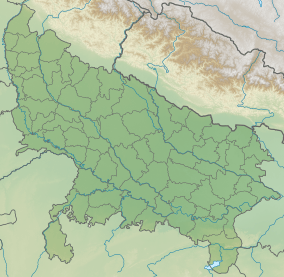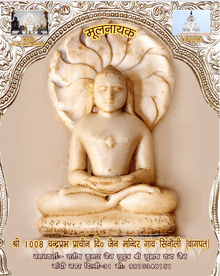Sinauli
Sinauli (Devanagiri: सिनौली) is an archaeological site located in Barot tehsil, Baghpat district, western Uttar Pradesh, India.[1][2] The site is famous for its Bronze Age solid disk wheel "chariots"(not spoked), the first ones to be recovered in archaeological excavation in South Asia.[3] Local legends tell that Sinauli is one of the five villages that god Krishna unsuccessfully negotiated with the Kaurava princes to avoid the War at Kurukshetra.[4]
 Sinauli Location within India  Sinauli Sinauli (Uttar Pradesh) | |
| Location | Barot tehsil, Baghpat district, Uttar Pradesh |
|---|---|
| Coordinates | 29°14′46″N 77°21′03″E |
| Type | Cemetery Royal Burial |
| History | |
| Cultures | Indus Civilisation |
| Site notes | |
| Discovered | 2005-06 |
| Excavation dates | 2005-06 2018 |
| Archaeologists | D. V. Sharma S. K. Manjul |
| Management | Archaeological Survey of India |
The excavations in Sinauli were conducted by Archaeological Survey of India (ASI) in 2005-06 and in mid-2018.[3] As per ASI and later studies[5][6], the remains found in 2005-06 season, the "Sanauli cemetery", belonged to Late Harappan Phase. The "Sanauli cemetery", like the extensive Harappan graveyard at Farmana, is expected to provide extensive additional data on the Late Harappan culture.[5]
Major findings from 2018 trial excavations include several wooden coffin burials, "chariots", copper swords, and helmets.The wooden chariots - with solid disk wheels - were protected by copper sheets.[3] [5] In December 2018 ASI approved a new phase of digging at Sinauli. The official communication from ASI was sent to an amateur archaeologist in Baraut.
Excavations
The site at Sinauli was accidentally discovered by people levelling agricultural land. The farmers came across human skeleton and ancient pottery. The Archaeological Survey of India (ASI) began excavations at the site in September 2005.[7]
Sanauli cemetery
The 2005-06 excavation headed by D. V. Sharma, ASI found more than a hundred burials (no coffins) tentatively dated c. 2200–1800 BCE.[6][3] Sharma, and later studies[5][6], associated the finding with the Harappan (Indus) civilisation.[3]
The burials are all oriented in a NW-SE direction and most are identified as primary burials. Some of the burials are identified as secondary, multiple and symbolic burials. The age of the buried starts from 1–2 years and includes all age groups and both male and female.[6] Grave goods generally consisted of odd number of vases/bowls (3, 5, 7, 9, 11 etc.) placed near the head, with dish-on-stand usually placed below the hip area as well as flask-shaped vessels, terracotta figurines, gold bracelets and copper bangles, beads of semi-precious stones (two necklaces of long barrel shape), steatite, faience, and glass.[7][6]
The two antennae swords from Sinauli, one found in situ in a grave with a copper sheath, has similarities to the Copper Hoard Type in a Late Harappan context.[6] A dish-on-stand and a violin-shaped flat copper container (having nearly 35 arrowhead shaped copper pieces placed in a row) are included in other important grave goods from Sinauli.[6] The survey found that a dish-on-stand was usually placed below the hip area, but in some cases was placed near the head or feet. The stand is holding the head of a goat in one case.[6]
Remains of a burnt brick wall with a finished inner surface ran along the eastern side of the burial. [7]
2018 excavations
— S. K. Manjul, ASI director (excavations)
Trial excavations conducted at Sinauli in March-May 2018 (about 100 m from the 2005-06 site) have yielded the remains of several coffin burials and three full-sized "chariots".[3] According to ASI director (excavations) Sanjay Manjul the burials may belong to the period c. 2000 - 1800 BCE.[1][3] Other discoveries include copper helmets, copper antenna swords, copper swords, a ladle made of copper, large terracotta pots, red vases with flaring rims, copper nails and beads.[3] Wooden coffins were first discovered at Harappa in Punjab and then from Dholavira in Gujarat.[8]
Local youths, after giving a basic training, were also enlisted into the excavation activities by the ASI.[4]
Seven human burials - including three coffin burials - have been excavated by the ASI at Sinauli in 2018.[3] In all burials the head was found to be on the northern side, with pottery beyond the head and on the south after the feet. The copper objects are kept below the "sarcophagi".[3]
- Coffin Burial I: Primary burial (2.4 m long and 40 cm high). Alongside two full-sized "chariots". No remains of a draught animal(s) - horse or bull - is found. The wooden parts of the coffin are decomposed.[3]
The wooden coffin stands on four wooden legs. The entire coffin, including legs, is covered with copper sheets (3mm thickness) on all sides. [3] The sides of the coffin have running floral motifs. The copper sheet on the legs also has intricate carvings.[3] The coffin lid has eight motifs carved (high relief) on it. It depicts either a person with a headgear (made of two bull horns and a pipal leaf in the centre) or a bull head.[3]
Body of an adult man inside the coffin: oriented in NW-SE direction (head facing NW).[3]
Chariots: Chariot have two solid wheels (not spoked). The wheels rotated on a fixed axle linked by a shaft to the yoke. The chassis of the two chariots are made of wood and covered with thick copper sheets.[3] The wheels are decorated with triangles made of copper (fastened on the wheel with copper nails). The triangles are distributed in three concentric circles from the hub flange of the wheel. The seat seemed to semi-circular. The frame of the seat is made of copper pipes. A pipe for the attachment of the umbrella is also visible. [3]
- Coffin Burial II: The third chariot was found with another wood coffin burial. The pit also included a shield (decorated with geometrical patterns in copper), a torch, an antenna sword, a digger, hundreds of beads and a variety of pots.[3] The chariot - unlike the ones found in the "two chariot burial" - has (copper triangle) decorations on the pole and yoke.[3]
- Coffin Burial III: Skeleton of a women (primary burial, coffin burial with no copper lid): wearing an armlet (made of banded agate beads around the elbow). Burial goods: 10 red vases with flared rims, four bowls, two basins, and a thin antenna sword.[3]
Jain Temple

The village also has a Jain temple which is believed to be around 200 years old. There is only one vedi and the moolnayak pratima (main idol) is of Bhagwan Chandraprabhu Swami, the eighth Teerthankara. The temple also has many handwritten manuscripts preserved since long. A grand pooja is held in the temple on 2nd October every year.
See also
- Indus Valley Civilization
- Mahabharata
References
- Rai, Sandeep. "ASI unearths ‘first-ever’ physical evidence of chariots in Copper Bronze Age" The Times of India 06 Jun. 2018.
- Sethi, Atul. "Grave Secrets of Sinauli" The Times of India 01 Jul. 2006.
- Subramanian, T. S. "Royal burial in Sanauli" Frontline 28 Sept. 2018
- Narayanan, P. M. "ASI-Excavated Sanauli Chariots Have Potential To Challenge Aryan Invasion Theory" Outlook 11 Jun. 2018.
- Witzel, Michael. "After Meluhha, The Melange" Outlook 02 Aug. 2018.
- Singh, Upinder. A History of Ancient and Early Medieval India: From the Stone Age to the 12th Century. Delhi: Pearson Education India, 2008. 215.
- "Excavations - 2006-2007". Archaeological Survey of India. Retrieved 29 June 2012.
- Subramanian, T. S. "From the Bara culture: R.S. Bisht". Frontline. Retrieved 3 January 2019.